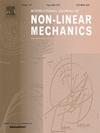Optimization method of vibration isolation performance of the 6DOF vibration isolation platform based on different configurations
IF 3.2
3区 工程技术
Q2 MECHANICS
International Journal of Non-Linear Mechanics
Pub Date : 2024-10-09
DOI:10.1016/j.ijnonlinmec.2024.104924
引用次数: 0
Abstract
The configuration optimization methods are developed to design the six degree of freedom (6DOF) passive vibration isolation platform with superior isolation performance. According to different position arrangements, various configuration vibration isolation platforms, including the 33 type, 63 type, 66–1 type, and 66–2 type, are designed and systematically analyzed. Through analysis of the geometric characteristics of the configuration platforms, the nonlinear dynamical equations for each configuration vibration isolation platform are established using Hamilton's principle. Utilizing the transmission rate as an evaluation index, the isolation performance of each platform in six directions (three translational and three rotational) is systematically studied. The results indicate that: (a) Through the comparative analysis of different configuration vibration isolation platforms, it can be found that the 66–1 configuration not only has the largest loading capacity but also owns the best isolation performance in the x, y, and γ directions. The 33 configuration has better isolation performance in the z, α, and β directions, while having greater loading capacity; (b) Through configuration optimization, a 6DOF vibration isolation platform can be obtained with high static stiffness in the vertical direction and low dynamic stiffness in other external excitation directions. This kind of HSLDS characteristics will significantly enhance the isolation performance of the vibration isolation platform; (c) Workspace analysis under different configurations reveals that the 66–1 configuration offers the largest workspace in all six directions, followed by the 63 configuration, while the workspaces of the 33 and 66–2 configurations are similar.
基于不同配置的 6DOF 隔振平台隔振性能优化方法
开发了配置优化方法来设计具有优异隔振性能的六自由度(6DOF)被动隔振平台。根据不同的位置布置,设计了 33 型、63 型、66-1 型和 66-2 型等多种构型隔振平台,并对其进行了系统分析。通过分析配置平台的几何特性,利用汉密尔顿原理建立了各配置隔振平台的非线性动力学方程。以传递率为评价指标,系统研究了每种平台在六个方向(三个平移方向和三个旋转方向)的隔振性能。结果表明(a) 通过对不同配置隔振平台的对比分析,可以发现 66-1 配置不仅承载能力最大,而且在 x、y 和 γ 方向的隔振性能最好。33 配置在 z、α 和 β 方向上具有更好的隔振性能,同时具有更大的承载能力;(b)通过配置优化,可以获得在垂直方向上具有高静态刚度,而在其他外部激励方向上具有低动态刚度的 6DOF 隔振平台。这种 HSLDS 特性将显著提高隔振平台的隔振性能;(c)不同配置下的工作空间分析表明,66-1 配置在所有六个方向上都具有最大的工作空间,63 配置次之,而 33 和 66-2 配置的工作空间相近。
本文章由计算机程序翻译,如有差异,请以英文原文为准。
求助全文
约1分钟内获得全文
求助全文
来源期刊
CiteScore
5.50
自引率
9.40%
发文量
192
审稿时长
67 days
期刊介绍:
The International Journal of Non-Linear Mechanics provides a specific medium for dissemination of high-quality research results in the various areas of theoretical, applied, and experimental mechanics of solids, fluids, structures, and systems where the phenomena are inherently non-linear.
The journal brings together original results in non-linear problems in elasticity, plasticity, dynamics, vibrations, wave-propagation, rheology, fluid-structure interaction systems, stability, biomechanics, micro- and nano-structures, materials, metamaterials, and in other diverse areas.
Papers may be analytical, computational or experimental in nature. Treatments of non-linear differential equations wherein solutions and properties of solutions are emphasized but physical aspects are not adequately relevant, will not be considered for possible publication. Both deterministic and stochastic approaches are fostered. Contributions pertaining to both established and emerging fields are encouraged.

 求助内容:
求助内容: 应助结果提醒方式:
应助结果提醒方式:


